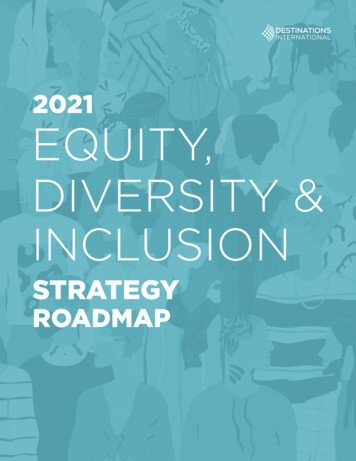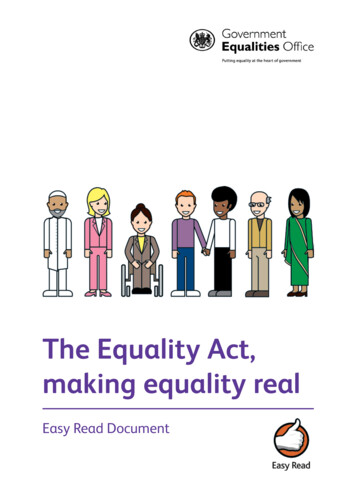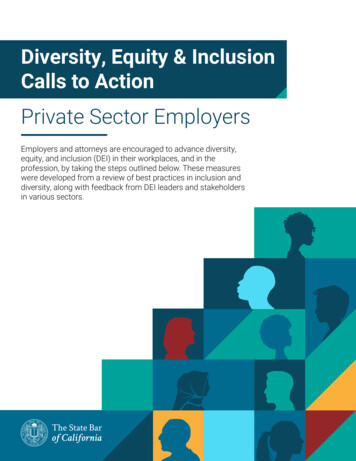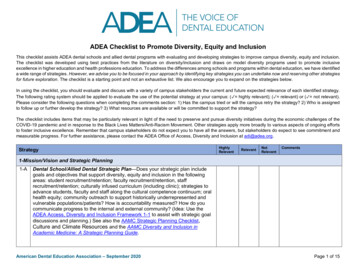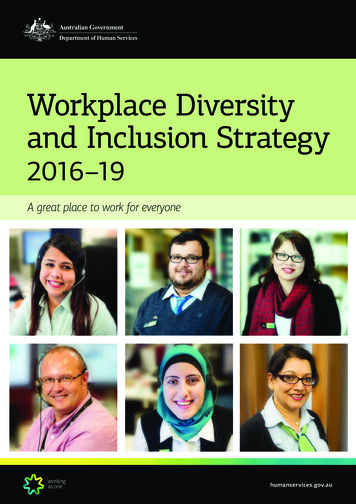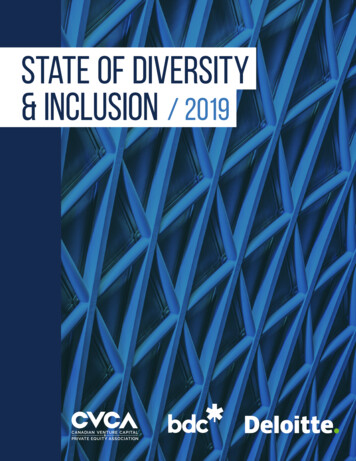
Transcription
EQUALITY, DIVERSITY& INCLUSIONStrategy2019 - 20221
ContentsIntroduction1King’s History2King’s Strategic Vision3Equality, Diversity & Inclusion at King’s: Our Vision4Six Strategic Pillars6Legislative Context7Equality, Diversity & Inclusion Governance & Strategic Resourcing8Three Functional Categories9Measures of Success & Key Performance Indicators10Equality, Diversity & Inclusion Strategic Goals12Equality, Diversity & Inclusion Strategic Priorities13Our Parnters142
IntroductionKing’s philosophy is ‘it’s our deeds that define us’. The core social value it espouses issomething we hold close to our hearts. It is particularly relevant when thinking aboutequality, diversity and inclusion.Our Strategic Vision 2029 takes us to King’s College London’s 200th anniversary. Itcommits us to building a community of learners and designing mainstream interventionsthat remove all forms of inequality and barriers to success.This is important to ensure we continue to attract the very best diverse student populationto our campuses situated in the heart of London, as well as continuing to attract and retaina talented and diverse staff body. Ensuring equality of opportunity and ensuring all typesof people and communities can thrive is vital to our civic mission and it is also ’just theright thing to do.’King’s Vision places commitment to service centre stage, linking our Londonopportunities to our global responsibilities. Our vision ‘to make the world a better place’and to be a civic university at the heart of London cannot be achieved without ensuringthat the breadth of our global and London communities and audiences are recognised.Universities such as King’s, that are committed to helping the world deal with changeneed to examine their own practices and behaviours and ensure they are leadingby example. We must ensure our institution mobilises the full capacity of its wholecommunity. Change and improvement must mean facing up to the deep problems ofgender and race (and other forms of) inequality which are still an issue in many researchintensive universities such as ourselves.1
History of King’s College LondonKing’s College London was founded by King George IV and the Duke of Wellington in1829 as a university college in the tradition of the Church of England. Since 1903, peopleof all religions and faiths have been able to study and work at King’s.The university has grown and developed through mergers with several institutions, eachwith their own distinguished histories, including The United Medical and Dental Schoolsof Guy’s and St Thomas Hospitals; Chelsea College of Technology; Queen ElizabethCollege; the Institute of Psychiatry; and the Florence Nightingale School of Nursing.The College is based over several campus sites within the London boroughs ofWestminster, Southwark and Lambeth. These are: Strand Campus (including The Maughan Library on Chancery Lane).Waterloo Campus.Guy’s Hospital site (including from 2018 The Science Gallery).St Thomas’ Hospital site.Denmark Hill (with departments and schools within the King’s College Hospital andSouth London and Maudsley Hospital sites).In addition, the School of Defence Studies operates out of The Defence Academy inShrivenham, Wiltshire. It is responsible for postgraduate education and training inleadership, business skills and technology for the UK Armed Forces, the Civil Service,diplomats and overseas forces and leaders. There are also students across the globestudying short courses and master’s programmes flexibly through King’s Online.2
King’s Strategic Vision 2029King’s Strategic Vision, launched in January 2017, takes the College to its 200th anniversary in 2029 and builds upon the history of being in service to society to make the world abetter place.King’s StrategicVision 2029Educate to inspire andimproveResearch to improve andinnovateServe to shape andtransformA civic university at theheart of LondonAn internationalcommunity that servesthe worldEach of these strategic pillars connects to the experiences andsuccesses of our colleagues, students and community, and is guided bythe core principle of an inclusive environment3
Equality, Diversity & Inclusionat King’s: Our VisionEquality, diversity and inclusion are central tenets of King’s Vision 2029 which sets outthe roadmap for King’s ambition to provide an exceptional student experience and tobe an employer of choice. Integral to this is recognising, celebrating and improving ourdiversity and inclusion. A key outcome of the Equality, Diversity & Inclusion Visionat King’s is a belief internally, externally and internationally that King’s is a place thatwelcomes diversity and where anyone with talent can thrive bringing to life the coreprinciple of an inclusive environment that threads through all of the five King’s Vision2029 strategic pillars. These together connect to create the experience and success of ourcolleagues, students and community.Equality, Diversity & Inclusion at King’s is led by a team of talented, enthusiastic experts,we work in close partnership with colleagues and students across the University, the sectorand the world. We also engage with partners with specific expertise to support and stretchour activity. These are shown on page 14. Together we are creating the foundations forfuture success. The release of authentic voices leads us to creativity, and transformation atthe heart of King’s core mission.Equality, diversity and inclusion are tangible things and they are critical to our successas a university in the 21st Century. They are outcomes and they are measurable. To betruly successful means recognising where current inequality or unfairness exists and how itcame to be.We live in a world that is not fair or equal, where privilege assists some, and the lack of itholds others back. Yet we know talent and potential are equally distributed throughoutthe population, regardless of background, identity or characteristic. Knowing this meanswe must take proactive steps to correct those imbalances and to ‘level the playing field’and fulfil our mission to unlock that talent and potential to really enable world leadingeducation, research and service.That is what the Equality, Diversity & Inclusion strategy sets out. It helps us all see wherethe disadvantage occurs, understand why and take steps to remove it, whilst celebratingthe richness that diversity of people, culture and thought brings.In recent years King’s has clarified its goals and held itself to a higher standard ofachievement. We have been brutally honest with ourselves about where we are and how,in places, we are a long way from our ambition. We know different people experienceKing’s differently based on who they are. We have identified the need to focus on the keyareas of leadership, management, awareness and community to address our issues. Theresearch we have done and the testimony we receive tell us many parts of our systems andprocesses don’t work effectively for all and that there are often perceptions of unfairness.Our strategy identifies key areas or continued investment and a systematic, holisticapproach to safeguarding equality, improving diversity and maximising inclusion. Theseare derived from King’s Vision 2029 and informed by the requirements set out in thePublic Sector Equality Duty.4
Vision PrinciplesBe intersectional by defaultAttract and retain a workforce that is representative of our student bodyEnsure the breadth of the workforce is productive and feels valuedand able to contributeAttract and retain a diverse student populationEnable successful outcomes in terms of degree attainment and employabilityfor the breadth of the student body5
Six Strategic Pillars123Legal complianceand servicefundamentalsHR transformationand functionalalignmentGovernance andaccountability456Inclusive cultureEducation,awareness anddevelopmentRecognition6
Legislative contextOur aim as shown above is to achieve more than compliance with the legislativerequirements of the Equality Act 2010, demonstrate best practice and, ultimately, to be anexemplar of EDI in the Higher Education sector and more widely. The panel below liststhe requirements placed upon King’s, as a public sector body by the Equality Act 2010.Equality Act ObligationsProtected CharacteristicsRaceReligion or BeliefAgeSexual OrientationSexMarriage or CivilPartnershipGenderReassignmentDisabilityDirect DiscriminationIndirect DiscriminationHarassmentPregnancy andMaternityVictimisationPublic Sector Duty RequirementsSpecific DutiesEliminate DiscriminationPublish relevant, proportionateinformation showing compliancewith Equality DutyAdvance Equality of OpportunityFoster good relations between differentgroups within King’s communityPublish Equality ObjectivesDemonstrate due regard for equality inpolicies and processes.7
Equality, Diversity& Inclusion GovernanceIn 2019 the governance of Equality, Diversity and Inclusion (EDI) at King’s wasimproved to better embed EDI through all structural levels of the College and tostrengthen accountability. King’s also committed to increase the required resourcesbehind these structures within a functionally-aligned Equality, Diversity & InclusionFunction to deliver on King’s Equality, Diversity & Inclusion Vision. More informationon our governance and reporting structures can be found on our website.Expertise & ResourcingKing’s is truly committed and has invested in developing EDI expertise and leadership– creating a cross university team. This is led by the Director of Equality, Diversity andInclusion who is responsible for establishing an Equality, Diversity and Inclusion strategyand leads the Equality, Diversity & Inclusion Function to ensure that it delivers activities,and coordinates with other College functions to achieve cross-university goals.This is resourced in a variety of ways across the university. Since October 2019 seven ofour nine faculties have worked collectively as part of a resourcing model: Faculty of Arts and HumanitiesFaculty of Dentistry, Oral & Craniofacial SciencesThe Dickson Poon School of LawFaculty of Natural and Mathematical SciencesFlorence Nightingale Faculty of Nursing and Midwifery and Palliative CareFaculty of Social Science and Public PolicyKing’s Business SchoolThe IoPPN and FOLSM each have dedicated EDI resource that works in partnershipwith the HR-led team.8
Three Functional Categories1Strategic insight andthought leadership23Centre of ExcellenceDelivery ofprogrammes andprojectsStandardisedmethodology, consistentworking practices andassurance across the entireKing’s context9Operating a flexibleresource pool whichenables prioritisationand agility
Measures of Success &Key Performance IndicatorsKing’s College London challenges itself to continually improve and has created a series ofKey Performance Indicators (KPIs) to manage and monitor progress towards key goals.Our EDI KPIs are set annually with progress monitored by our Council.Intersectional KPIs are being trialled for future inclusion in the balanced scorecard.Our two Scorecard measures are: Gender representation in senior levels, for Academic andProfessional Services Staff.Black and Minority Ethnic (BME) representation at all levels, for Academicand Professional Services Staff.Other metrics include: Gender and Ethnicity Pay Gap Student attainment/awarding gap Achieving an Athena Swan Silver in 2020 Maintaining all current Athena Swan awards and increasing the coverage year on year Renewing our Race Equality Chartermark in 2020 Improving our place in the Stonewall Workplace Equality Index from 263rd in 2018 Improving our score against the Business Disability Forum Self-assessmentWe are also working with the Business Analytics team on developing some qualitativemeasures.The metrics for Professional Services are established at the university-level, whileacademic targets are set in tandem with faculties. We have recently developed anintersectional KPI which looks at the representation of women of colour in our workforce.This is being trialled and will be included in the balanced scorecard from November2019.Our 2020 baseline shows we are exceeding our self-set target for senior academic femalestaff and have been increasing the representation of senior female staff each year. We alsoexceeded our target for Professional Services staff although we have had less consistentprogress over five years, showing a decline between 2013/14 and 2015/16.10
Our BME representation in academic roles is above the sector average, and our futuretargets will move us closer to the upper quartile. Our BME representation in ProfessionalServices shows a similar story, as we are above the London Higher Education (HE) meanbenchmark and moving towards the upper quartile target for BME representation. Thisshows a positive trend.However, we need to be mindful that HE has overall low representation and, while itpresents a contextual and relevant benchmark, it is not the most stretching comparator, asHE is not seen as leader in sex and ethnicity inclusion.We need to aim higher, including through developing qualitative benchmarks usingmeasures of experience of groups within King’s. We know through our surveys thatwhile representation of BME and female colleagues is increasing, there is a qualitativeexperience gap, in terms of belonging, inclusion and perceptions of fairness which is notyet captured in KPIs.As of dateMetric NameCurrent ValueComparison toTargetTarget2018/191a. Senior Female Staff Academic (%)36.8-0.7%37.12018/191b. Senior Female Staff Professional Services (%)49.7 2.1%48.72018/192a. BME Staff - Academic (%)20.6 3.6%19.82018/192b. BME Staff Professional Services (%)21.7 3.2%21.011
Equality, Diversity& Inclusion Strategic Goals To develop a more inclusive culture via more capable, inclusive leadership andmanagement Enable all parts of the community feel valued and able to succeed throughpromoting the benefits of inclusive behaviour and ensuring unacceptable behaviouris addressedTo diversify Senior Leadership Increase proportion of women in senior and leadership positions Increase proportion of BME colleagues in senior and leadership positions To ensure representation of protected groups of staff is proportionate throughout allProfessional Services and Academic grades, especially for BME staff To address the Ethnicity, Pay Gap To address the Gender Pay Gap12
Equality, Diversity & InclusionStrategic Priorities 2019-20221234Governance & accountabilityImprove foundations, ensure legal compliance and tackle risks;Improve accountability, leadership and decision making;Improve workforce equality data collection.Workforce developmentImprove management capacity;Promote the benefits of inclusive behaviourImprove mechanisms for addressing unacceptable behaviourMore capable, inclusive leadership and management practice.Workplace representationIncrease proportion of women in senior positions;Increase the proportion of BME colleagues in senior positions;Improve inclusion and progression across protected characteristics in all staff groups;Address ethnicity and gender pay gaps.Staff disability inclusionImprove inclusion for disabled staff;Ensuring efficient and supportive reasonable adjustments;Building awareness and education around disability;Increasing confidence in our disabled staff that they can trust usEvaluation and recognition5Attainment of an institutional wide Athena SWAN silver award in 2020;Renewal of the institutional-wide Race Equality Charter Bronze award in 2020;Submission to the 2021 Stonewall WEI and improvement of our overall ranking;Submission to the Working Families benchmark in 2020.Address differential student outcomes6This work is led by the Social Mobility & Student Success Directorate which includesthe Student Outcomes Service. EDI have worked in partnership to develop their work incontinuing to close undergraduate BME attainment gap at ‘good’ degree and first-classlevels; their main areas we are supporting on are theImplementation of a university-wide network of InclusiveEducation Partners (academic & student staff);Pilot Conversations about Race, to increase student belonging.13
Our PartnersTHE GLOBALINSTITUTEFOR WOMEN’SLEADERSHIP14
Equality, Diversity & InclusionKing’s College LondonHuman ResourcesJames Clerk Maxwell logs.kcl.ac.uk/diversity@KCLDiversity15
Key Performance Indicators (KPIs) to manage and monitor progress towards key goals. Our EDI KPIs are set annually with progress monitored by our Council. Intersectional KPIs are being trialled for future inclusion in the balanced scorecard. Our two Scorecard measures are: Gender representation in senior levels, for Academic and



